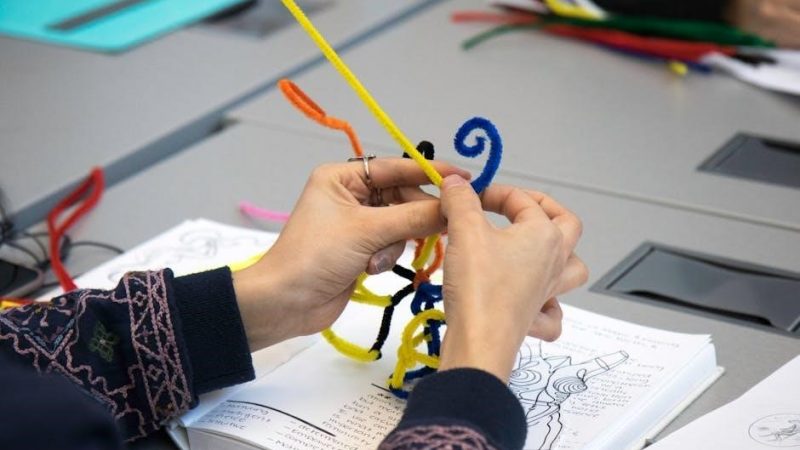differentiated instruction vs universal design for learning

Differentiated Instruction (DI) and Universal Design for Learning (UDL) are educational approaches designed to meet diverse student needs․ DI focuses on tailoring instruction to individual learners, while UDL emphasizes creating flexible, accessible learning environments for all students․ Both aim to enhance engagement, understanding, and achievement by addressing unique learning requirements․
1․1 Definition and Overview of Differentiated Instruction (DI)
Differentiated Instruction (DI) is an educational approach that tailors teaching methods to meet the diverse needs of individual students․ It focuses on adjusting content, process, and products to suit varying readiness levels, learning styles, and interests․ DI emphasizes flexibility and proactive planning to ensure all students can access learning materials effectively, fostering academic growth without lowering standards․ It is rooted in understanding student needs and adapting instruction accordingly․
1․2 Definition and Overview of Universal Design for Learning (UDL)
Universal Design for Learning (UDL) is an educational framework that emphasizes flexibility in lesson design to meet the diverse needs of all learners․ It focuses on providing multiple means of engagement, representation, and action to ensure accessibility and inclusivity․ UDL is proactive, designing learning environments that accommodate individual differences from the start, rather than making adjustments after instruction begins․

Core Principles of Differentiated Instruction
Differentiated Instruction (DI) focuses on tailoring teaching methods to meet individual student needs by adjusting content, process, and products․ It considers learning styles and interests to ensure all learners can achieve their goals․
2․1 Understanding Student Needs and Readiness Levels
Understanding student needs and readiness levels is crucial in Differentiated Instruction (DI)․ Teachers use pre-assessments and ongoing evaluations to identify learners’ strengths, weaknesses, and learning styles․ This understanding allows educators to tailor instruction, ensuring content is appropriately challenging and aligned with individual developmental stages․ Recognizing readiness levels helps in providing scaffolding or enrichment, making learning accessible and engaging for all students․
2․2 Adjusting Content, Process, and Products to Meet Individual Needs
In Differentiated Instruction, teachers adapt content, process, and products to cater to diverse learner needs․ Content adjustments involve modifying materials to suit readiness levels․ The process includes varying instructional strategies, while products allow students to demonstrate learning in ways that reflect their strengths․ This approach ensures each student can access and engage with the curriculum effectively, fostering personalized growth and understanding․
2․3 The Role of Learning Styles and Interests in DI
Differentiated Instruction leverages students’ learning styles and interests to create engaging lessons․ By understanding how each learner prefers to absorb information—visually, auditory, or kinesthetically—teachers can tailor delivery methods․ Incorporating student interests makes content relevant, boosting motivation and participation․ This personalized approach ensures that learning is meaningful and caters to individual preferences, enhancing overall academic engagement and success for all students․
Core Principles of Universal Design for Learning
UDL emphasizes flexibility in lesson design and student groupings, providing multiple means of engagement, representation, and action to ensure accessible and inclusive learning experiences for all students․
3․1 Flexibility in Lesson Design and Student Groupings
Flexibility in lesson design and student groupings is a cornerstone of Universal Design for Learning (UDL)․ It involves creating adaptable learning environments that cater to diverse student needs, allowing for varied instructional strategies and groupings․ This approach ensures that all learners can engage with content in ways that suit their individual preferences and abilities, fostering inclusivity and maximizing engagement․ By offering choices and adjusting instructional methods, teachers can better meet the unique requirements of their students․
3․2 Providing Multiple Means of Engagement, Representation, and Action
Universal Design for Learning (UDL) emphasizes providing multiple means of engagement, representation, and action to cater to diverse learning needs․ Engagement involves motivating students through choice and interactive activities․ Representation offers content in various formats—text, images, videos—to ensure accessibility․ Action allows students to demonstrate learning through diverse methods, such as writing, presentations, or hands-on tasks, promoting flexibility and inclusivity in the learning process․
Key Differences Between DI and UDL
Differentiated Instruction (DI) focuses on individual adjustments, while Universal Design for Learning (UDL) proactively designs lessons for accessibility․ DI is reactive, addressing specific needs, whereas UDL is proactive, ensuring universal accessibility from the start․
4․1 Focus on Individual vs․ Universal Accessibility
Differentiated Instruction (DI) focuses on individual student needs, tailoring content, process, and products to meet specific learners․ In contrast, Universal Design for Learning (UDL) emphasizes universal accessibility, designing lessons proactively to meet diverse needs upfront․ DI is teacher-driven, while UDL is learner-centered, aiming to remove barriers for all students, ensuring equitable access to learning from the start․
4․2 Proactive vs․ Reactive Approach to Learning
Differentiated Instruction (DI) often involves a reactive approach, adjusting instruction based on student responses and needs as they arise․ In contrast, Universal Design for Learning (UDL) adopts a proactive approach, designing flexible lessons upfront to anticipate and address diverse learning needs․ UDL aims to minimize barriers before they impact learning, while DI responds to individual challenges as they emerge during instruction․

Practical Implementation Strategies
Implementing DI involves assessing student needs, varying content delivery, and incorporating learning styles․ UDL focuses on flexible lesson designs and multiple engagement options for all learners․
- DI: Tailor content, process, and products to individual needs․
- UDL: Design flexible lessons with multiple means of engagement and representation․
5․1 Strategies for Implementing Differentiated Instruction
Effective DI strategies include assessing student readiness, interests, and learning profiles to tailor instruction․ Teachers can vary content, process, and products, incorporating learning styles and preferences․ Grouping students flexibly, using technology tools, and providing choice boards are practical approaches․ Additionally, scaffolding instruction, offering tiered assignments, and integrating formative assessments help meet diverse needs, ensuring personalized learning experiences for all students․
5․2 Strategies for Implementing Universal Design for Learning
UDL implementation involves designing lessons with flexibility in mind․ Strategies include offering multiple means of engagement, representation, and action․ Teachers provide varied content formats, such as text, audio, and video, and allow students to express learning in diverse ways․ Incorporating choice boards, interactive simulations, and accessible technologies ensures all learners can access and engage with the material effectively from the start․
Technology’s Role in Supporting Both Approaches
Technology enhances both Differentiated Instruction and Universal Design for Learning by providing flexible, accessible tools․ It supports personalized learning paths, interactive simulations, and multimedia resources, ensuring diverse needs are met effectively․
6․1 Tools for Differentiated Instruction
Learning Management Systems (LMS) and adaptive learning software are key tools for Differentiated Instruction․ These platforms allow teachers to assign personalized content, track progress, and provide real-time feedback․ Educational apps and multimedia resources also support diverse learning styles by offering interactive and engaging materials․ Additionally, data analytics tools help educators identify individual needs and adjust instruction accordingly, ensuring tailored learning experiences․
6․2 Tools for Universal Design for Learning
Universal Design for Learning (UDL) leverages tools like text-to-speech software and interactive simulations to provide multiple means of engagement, representation, and action․ Multimedia resources and gamification platforms enhance accessibility, while assistive technologies such as speech-to-text support diverse learning needs․ These tools ensure flexibility and accessibility, allowing students to engage with content in ways that suit their individual preferences and abilities․
Challenges and Misconceptions
Implementing differentiated instruction and UDL presents challenges, including time-intensive planning and misconceptions about lowering academic standards․ Addressing these requires professional development and clear communication about the benefits of tailored learning approaches․
7․1 Common Challenges in Implementing DI and UDL
Implementing DI and UDL poses challenges, such as time-intensive planning, balancing individual needs, and addressing misconceptions about lowering academic standards․ Teachers often struggle with limited resources, lack of training, and managing diverse learning profiles․ Additionally, the complexity of creating flexible, universally accessible lessons can overwhelm educators, highlighting the need for professional development and supportive frameworks to ensure successful implementation․
7․2 Addressing Misconceptions About Differentiated Instruction
A common misconception is that DI lowers academic standards or creates unfairness․ It is not about reducing expectations but tailoring instruction to meet diverse needs․ Another myth is that DI is overly time-consuming, yet effective planning and strategies can streamline its implementation․ Understanding DI as a flexible, student-centered approach helps dispel misconceptions and promotes its successful integration into classroom practices․

Case Studies and Real-World Applications
Real-world applications of Differentiated Instruction and Universal Design for Learning showcase their effectiveness․ For instance, a high school implemented DI by grouping students based on readiness levels, while an elementary school used UDL to create accessible materials and multiple engagement options for all learners․
8․1 Successful Examples of DI in the Classroom
A high school math teacher used flexible grouping based on student readiness levels, allowing tailored instruction․ Another example involved tiered assignments, where tasks varied in complexity to match student proficiency․ Additionally, a classroom incorporated learning centers, offering interactive activities that catered to different learning styles․ These strategies enhanced engagement and understanding, demonstrating DI’s effectiveness in addressing diverse student needs effectively in real-world settings․
8․2 Successful Examples of UDL in the Classroom
Classrooms implementing Universal Design for Learning (UDL) often offer multi-modal materials, such as text, videos, and interactive simulations, to cater to various learning preferences․ Teachers provide choice boards allowing students to select how they demonstrate learning, whether through presentations, written reports, or hands-on projects․ Additionally, incorporating assistive technologies and adaptable learning environments ensures accessibility for all, promoting inclusivity and engagement․

The Future of Differentiated Instruction and UDL
The integration of DI and UDL is expected to shape future education, leveraging technology for personalized learning․ These approaches will likely evolve to create more inclusive, dynamic, and effective classrooms․
9․1 Evolving Trends in Personalized Learning
Personalized learning is evolving rapidly, with DI and UDL at the forefront․ Technology, such as adaptive learning software and AI, is enabling more precise tailoring of instruction to individual needs․ Competency-based progression and micro-credentials are gaining traction, allowing students to demonstrate mastery at their own pace․ These trends emphasize flexibility, student agency, and data-driven approaches to create more equitable and effective learning experiences for all students․
9․2 The Potential for Integration of DI and UDL
Integrating Differentiated Instruction (DI) and Universal Design for Learning (UDL) offers a powerful approach to education․ By combining DI’s focus on individual needs with UDL’s emphasis on accessible design, educators can create learning environments that are both flexible and inclusive․ This integration allows for more personalized and engaging experiences, ensuring that all students can access and succeed in their learning journeys․
Such an approach fosters innovation and equity in education, addressing the diverse needs of modern learners while maintaining high academic standards․ The synergy between DI and UDL has the potential to transform teaching practices, making learning more meaningful and effective for every student․
10․1 Summary of Key Points
Differentiated Instruction (DI) and Universal Design for Learning (UDL) are complementary approaches that prioritize student-centered learning․ DI tailors instruction to meet individual needs, while UDL creates flexible learning environments․ Both emphasize understanding, engagement, and accessibility, ensuring all students can succeed․ By addressing diverse learning styles and readiness levels, these approaches foster inclusivity and equity in education, preparing students for future challenges․
10․2 Final Thoughts on the Importance of Tailored Learning Approaches
Tailored learning approaches like DI and UDL are essential for creating inclusive, effective classrooms․ By addressing diverse needs, these methods ensure equity and empowerment for all students․ They foster deeper engagement, understanding, and achievement, preparing learners for future challenges․ Embracing these strategies is crucial for educators committed to meeting the unique potential of every student․





